Audit and Professional Practice Report: Cyan Enterprises, BUS000
VerifiedAdded on 2023/06/05
|11
|2616
|292
Report
AI Summary
This report presents an audit planning analysis for Cyan Enterprises, a small entity. It begins with an executive summary and table of contents, followed by an introduction outlining authorization, limitations, and scope. The report then delves into the inputs, including a trial balance and the determination of materiality using various financial metrics. Preliminary analytical reviews, such as variance analysis and common size income statements, are conducted. The discussion section analyzes key income statement accounts, identifies audit assertions and risks, and outlines appropriate audit procedures. The report emphasizes the importance of fraud risk analysis and provides recommendations for the audit process, including a call for mandatory fraud risk assessment and balance sheet analysis. The report references several academic sources to support its findings and recommendations.
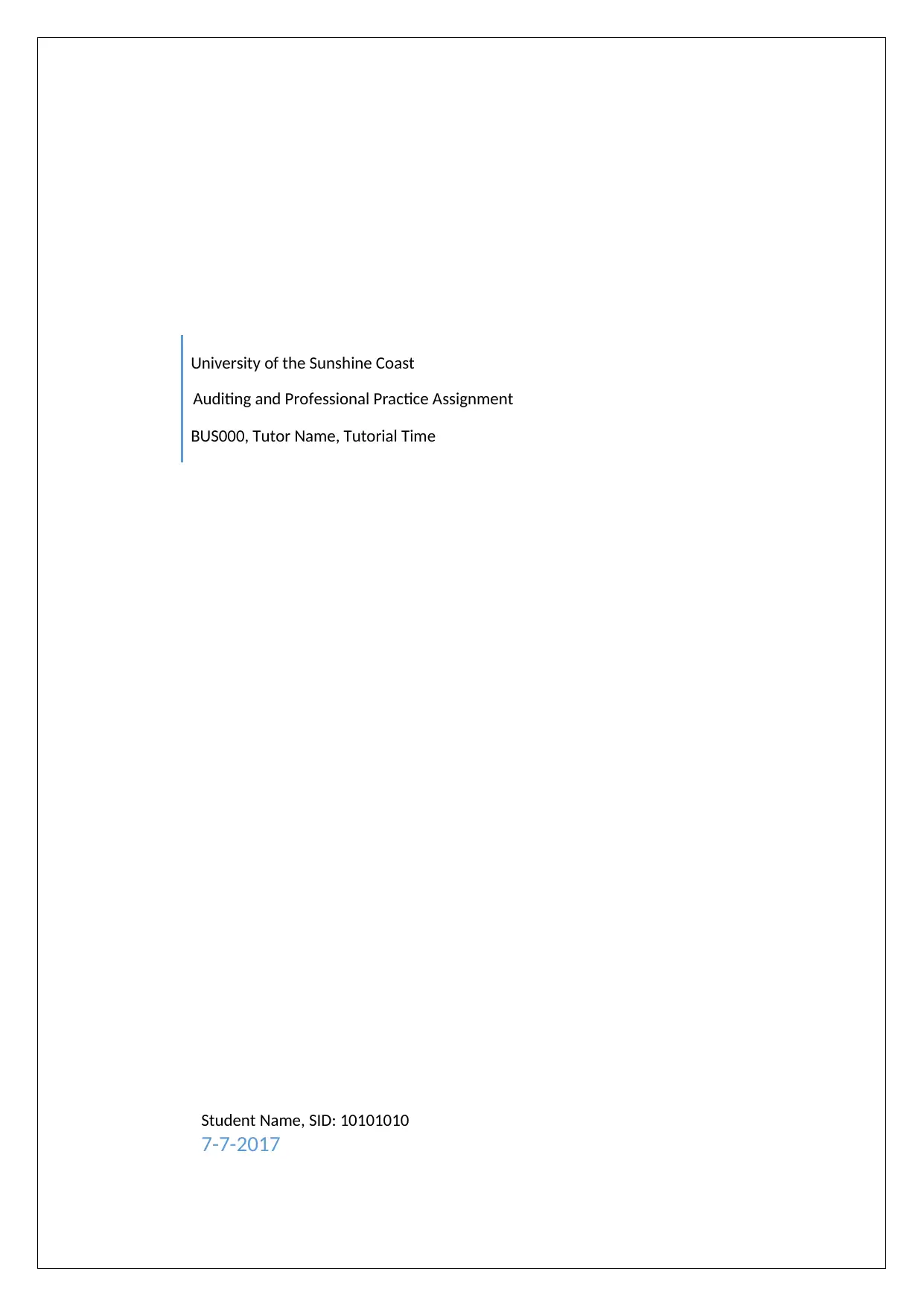
University of the Sunshine Coast
Auditing and Professional Practice Assignment
BUS000, Tutor Name, Tutorial Time
Student Name, SID: 10101010
7-7-2017
Auditing and Professional Practice Assignment
BUS000, Tutor Name, Tutorial Time
Student Name, SID: 10101010
7-7-2017
Paraphrase This Document
Need a fresh take? Get an instant paraphrase of this document with our AI Paraphraser
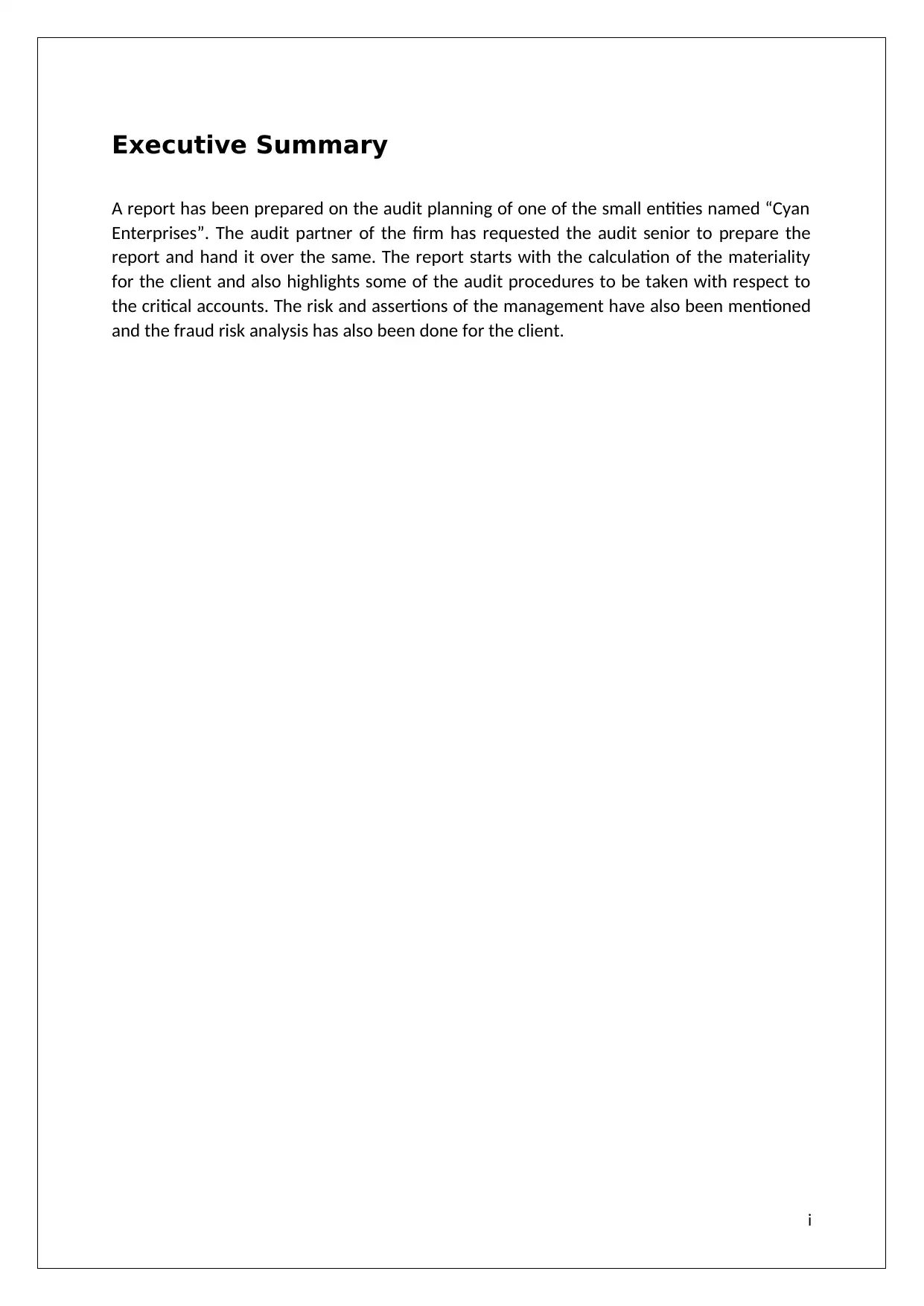
Executive Summary
A report has been prepared on the audit planning of one of the small entities named “Cyan
Enterprises”. The audit partner of the firm has requested the audit senior to prepare the
report and hand it over the same. The report starts with the calculation of the materiality
for the client and also highlights some of the audit procedures to be taken with respect to
the critical accounts. The risk and assertions of the management have also been mentioned
and the fraud risk analysis has also been done for the client.
i
A report has been prepared on the audit planning of one of the small entities named “Cyan
Enterprises”. The audit partner of the firm has requested the audit senior to prepare the
report and hand it over the same. The report starts with the calculation of the materiality
for the client and also highlights some of the audit procedures to be taken with respect to
the critical accounts. The risk and assertions of the management have also been mentioned
and the fraud risk analysis has also been done for the client.
i
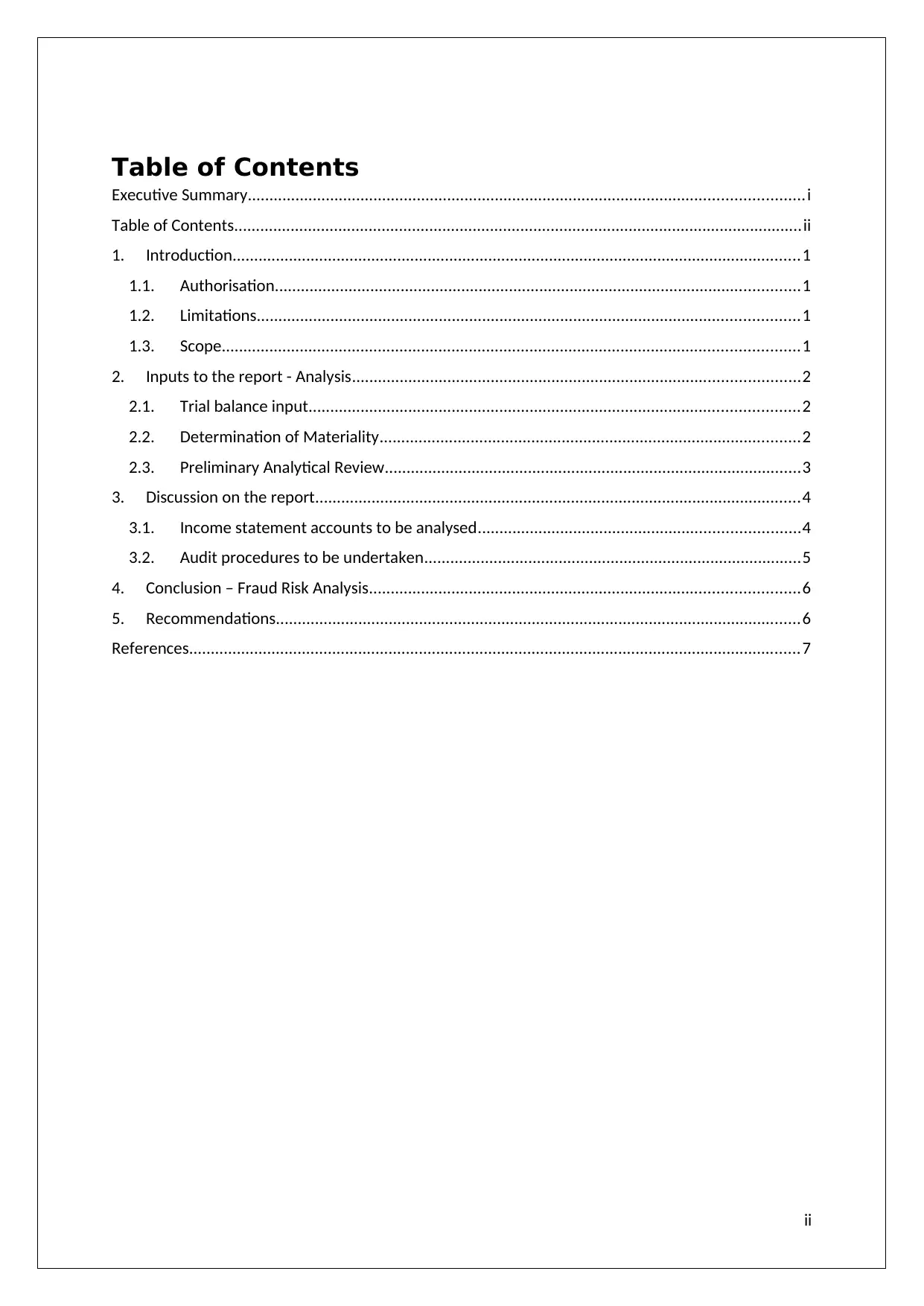
Table of Contents
Executive Summary................................................................................................................................i
Table of Contents...................................................................................................................................ii
1. Introduction...................................................................................................................................1
1.1. Authorisation.........................................................................................................................1
1.2. Limitations.............................................................................................................................1
1.3. Scope.....................................................................................................................................1
2. Inputs to the report - Analysis.......................................................................................................2
2.1. Trial balance input.................................................................................................................2
2.2. Determination of Materiality.................................................................................................2
2.3. Preliminary Analytical Review................................................................................................3
3. Discussion on the report................................................................................................................4
3.1. Income statement accounts to be analysed..........................................................................4
3.2. Audit procedures to be undertaken.......................................................................................5
4. Conclusion – Fraud Risk Analysis...................................................................................................6
5. Recommendations.........................................................................................................................6
References.............................................................................................................................................7
ii
Executive Summary................................................................................................................................i
Table of Contents...................................................................................................................................ii
1. Introduction...................................................................................................................................1
1.1. Authorisation.........................................................................................................................1
1.2. Limitations.............................................................................................................................1
1.3. Scope.....................................................................................................................................1
2. Inputs to the report - Analysis.......................................................................................................2
2.1. Trial balance input.................................................................................................................2
2.2. Determination of Materiality.................................................................................................2
2.3. Preliminary Analytical Review................................................................................................3
3. Discussion on the report................................................................................................................4
3.1. Income statement accounts to be analysed..........................................................................4
3.2. Audit procedures to be undertaken.......................................................................................5
4. Conclusion – Fraud Risk Analysis...................................................................................................6
5. Recommendations.........................................................................................................................6
References.............................................................................................................................................7
ii
⊘ This is a preview!⊘
Do you want full access?
Subscribe today to unlock all pages.

Trusted by 1+ million students worldwide
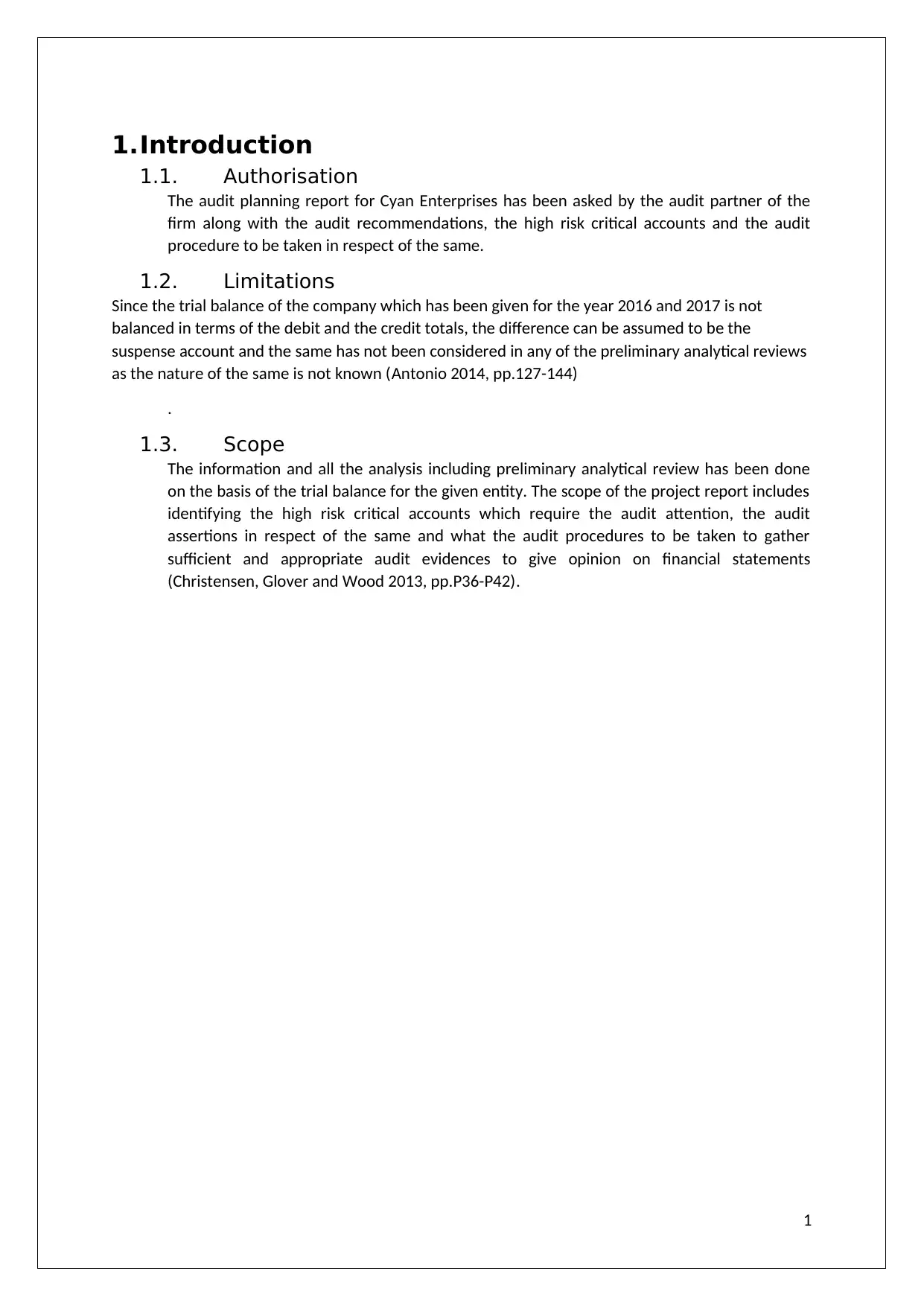
1.Introduction
1.1. Authorisation
The audit planning report for Cyan Enterprises has been asked by the audit partner of the
firm along with the audit recommendations, the high risk critical accounts and the audit
procedure to be taken in respect of the same.
1.2. Limitations
Since the trial balance of the company which has been given for the year 2016 and 2017 is not
balanced in terms of the debit and the credit totals, the difference can be assumed to be the
suspense account and the same has not been considered in any of the preliminary analytical reviews
as the nature of the same is not known (Antonio 2014, pp.127-144)
.
1.3. Scope
The information and all the analysis including preliminary analytical review has been done
on the basis of the trial balance for the given entity. The scope of the project report includes
identifying the high risk critical accounts which require the audit attention, the audit
assertions in respect of the same and what the audit procedures to be taken to gather
sufficient and appropriate audit evidences to give opinion on financial statements
(Christensen, Glover and Wood 2013, pp.P36-P42).
1
1.1. Authorisation
The audit planning report for Cyan Enterprises has been asked by the audit partner of the
firm along with the audit recommendations, the high risk critical accounts and the audit
procedure to be taken in respect of the same.
1.2. Limitations
Since the trial balance of the company which has been given for the year 2016 and 2017 is not
balanced in terms of the debit and the credit totals, the difference can be assumed to be the
suspense account and the same has not been considered in any of the preliminary analytical reviews
as the nature of the same is not known (Antonio 2014, pp.127-144)
.
1.3. Scope
The information and all the analysis including preliminary analytical review has been done
on the basis of the trial balance for the given entity. The scope of the project report includes
identifying the high risk critical accounts which require the audit attention, the audit
assertions in respect of the same and what the audit procedures to be taken to gather
sufficient and appropriate audit evidences to give opinion on financial statements
(Christensen, Glover and Wood 2013, pp.P36-P42).
1
Paraphrase This Document
Need a fresh take? Get an instant paraphrase of this document with our AI Paraphraser
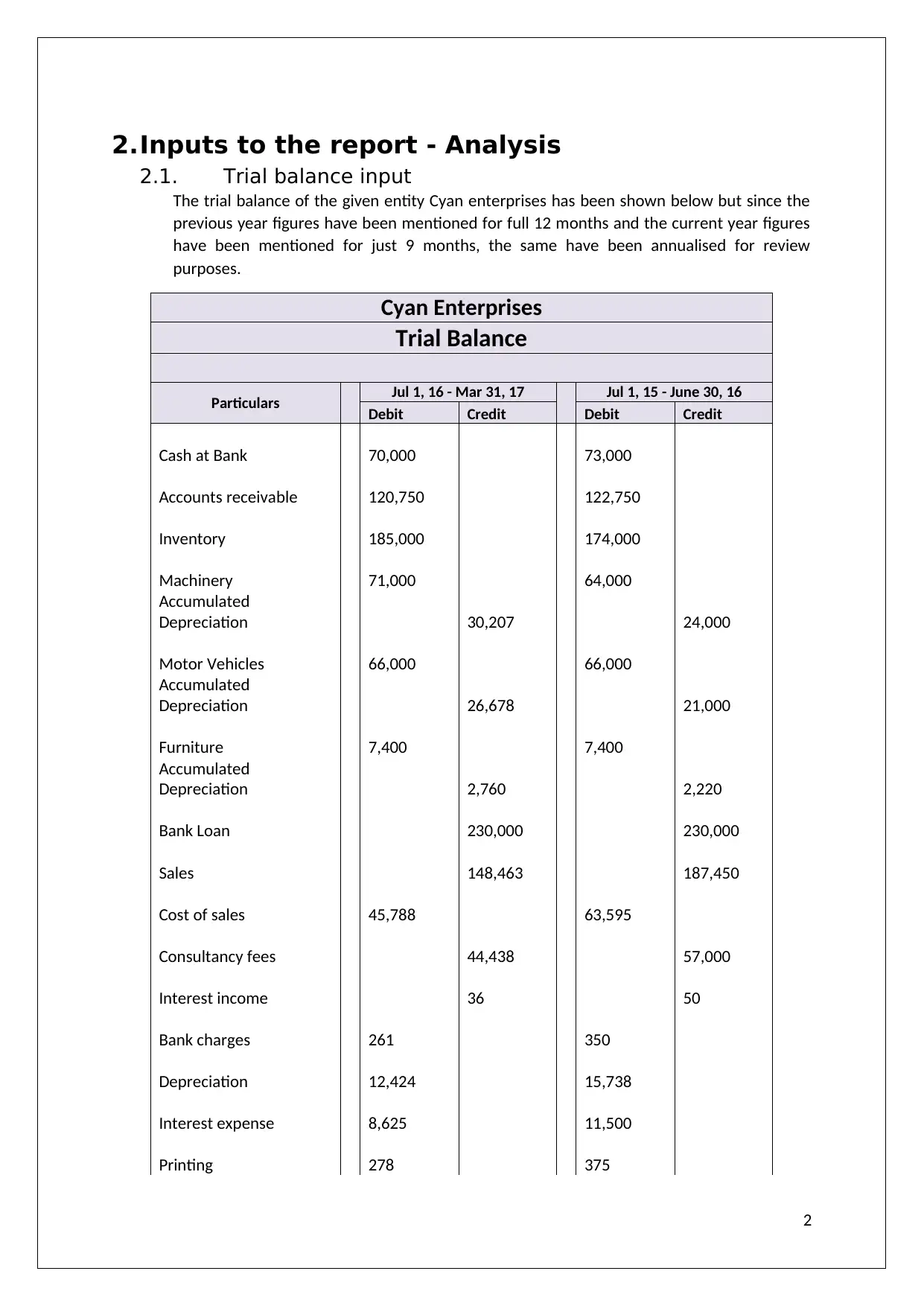
2.Inputs to the report - Analysis
2.1. Trial balance input
The trial balance of the given entity Cyan enterprises has been shown below but since the
previous year figures have been mentioned for full 12 months and the current year figures
have been mentioned for just 9 months, the same have been annualised for review
purposes.
Cyan Enterprises
Trial Balance
Particulars Jul 1, 16 - Mar 31, 17 Jul 1, 15 - June 30, 16
Debit Credit Debit Credit
Cash at Bank 70,000 73,000
Accounts receivable 120,750 122,750
Inventory 185,000 174,000
Machinery 71,000 64,000
Accumulated
Depreciation 30,207 24,000
Motor Vehicles 66,000 66,000
Accumulated
Depreciation 26,678 21,000
Furniture 7,400 7,400
Accumulated
Depreciation 2,760 2,220
Bank Loan 230,000 230,000
Sales 148,463 187,450
Cost of sales 45,788 63,595
Consultancy fees 44,438 57,000
Interest income 36 50
Bank charges 261 350
Depreciation 12,424 15,738
Interest expense 8,625 11,500
Printing 278 375
2
2.1. Trial balance input
The trial balance of the given entity Cyan enterprises has been shown below but since the
previous year figures have been mentioned for full 12 months and the current year figures
have been mentioned for just 9 months, the same have been annualised for review
purposes.
Cyan Enterprises
Trial Balance
Particulars Jul 1, 16 - Mar 31, 17 Jul 1, 15 - June 30, 16
Debit Credit Debit Credit
Cash at Bank 70,000 73,000
Accounts receivable 120,750 122,750
Inventory 185,000 174,000
Machinery 71,000 64,000
Accumulated
Depreciation 30,207 24,000
Motor Vehicles 66,000 66,000
Accumulated
Depreciation 26,678 21,000
Furniture 7,400 7,400
Accumulated
Depreciation 2,760 2,220
Bank Loan 230,000 230,000
Sales 148,463 187,450
Cost of sales 45,788 63,595
Consultancy fees 44,438 57,000
Interest income 36 50
Bank charges 261 350
Depreciation 12,424 15,738
Interest expense 8,625 11,500
Printing 278 375
2
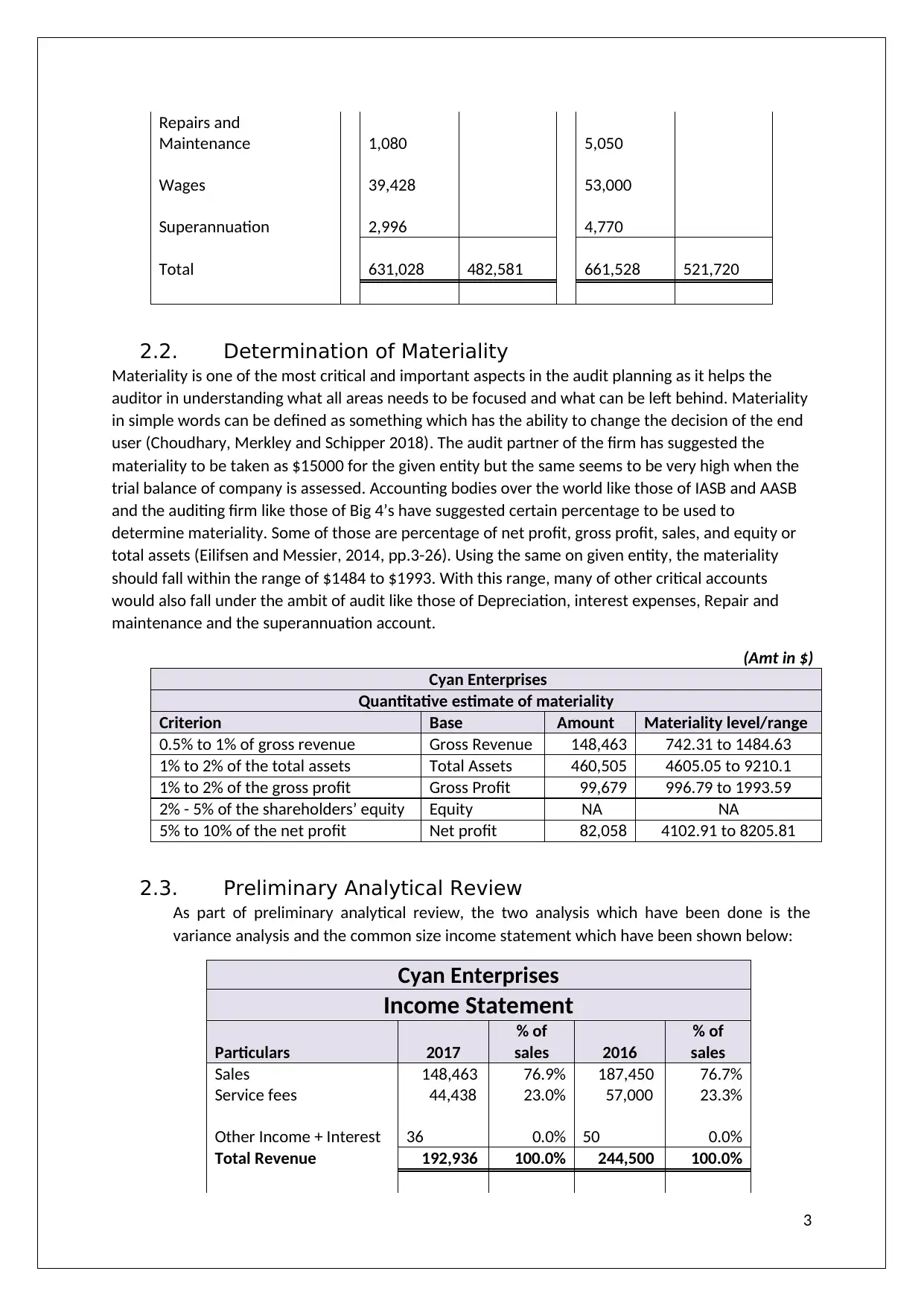
Repairs and
Maintenance 1,080 5,050
Wages 39,428 53,000
Superannuation 2,996 4,770
Total 631,028 482,581 661,528 521,720
2.2. Determination of Materiality
Materiality is one of the most critical and important aspects in the audit planning as it helps the
auditor in understanding what all areas needs to be focused and what can be left behind. Materiality
in simple words can be defined as something which has the ability to change the decision of the end
user (Choudhary, Merkley and Schipper 2018). The audit partner of the firm has suggested the
materiality to be taken as $15000 for the given entity but the same seems to be very high when the
trial balance of company is assessed. Accounting bodies over the world like those of IASB and AASB
and the auditing firm like those of Big 4’s have suggested certain percentage to be used to
determine materiality. Some of those are percentage of net profit, gross profit, sales, and equity or
total assets (Eilifsen and Messier, 2014, pp.3-26). Using the same on given entity, the materiality
should fall within the range of $1484 to $1993. With this range, many of other critical accounts
would also fall under the ambit of audit like those of Depreciation, interest expenses, Repair and
maintenance and the superannuation account.
(Amt in $)
Cyan Enterprises
Quantitative estimate of materiality
Criterion Base Amount Materiality level/range
0.5% to 1% of gross revenue Gross Revenue 148,463 742.31 to 1484.63
1% to 2% of the total assets Total Assets 460,505 4605.05 to 9210.1
1% to 2% of the gross profit Gross Profit 99,679 996.79 to 1993.59
2% - 5% of the shareholders’ equity Equity NA NA
5% to 10% of the net profit Net profit 82,058 4102.91 to 8205.81
2.3. Preliminary Analytical Review
As part of preliminary analytical review, the two analysis which have been done is the
variance analysis and the common size income statement which have been shown below:
Cyan Enterprises
Income Statement
Particulars 2017
% of
sales 2016
% of
sales
Sales 148,463 76.9% 187,450 76.7%
Service fees 44,438 23.0% 57,000 23.3%
Other Income + Interest 36 0.0% 50 0.0%
Total Revenue 192,936 100.0% 244,500 100.0%
3
Maintenance 1,080 5,050
Wages 39,428 53,000
Superannuation 2,996 4,770
Total 631,028 482,581 661,528 521,720
2.2. Determination of Materiality
Materiality is one of the most critical and important aspects in the audit planning as it helps the
auditor in understanding what all areas needs to be focused and what can be left behind. Materiality
in simple words can be defined as something which has the ability to change the decision of the end
user (Choudhary, Merkley and Schipper 2018). The audit partner of the firm has suggested the
materiality to be taken as $15000 for the given entity but the same seems to be very high when the
trial balance of company is assessed. Accounting bodies over the world like those of IASB and AASB
and the auditing firm like those of Big 4’s have suggested certain percentage to be used to
determine materiality. Some of those are percentage of net profit, gross profit, sales, and equity or
total assets (Eilifsen and Messier, 2014, pp.3-26). Using the same on given entity, the materiality
should fall within the range of $1484 to $1993. With this range, many of other critical accounts
would also fall under the ambit of audit like those of Depreciation, interest expenses, Repair and
maintenance and the superannuation account.
(Amt in $)
Cyan Enterprises
Quantitative estimate of materiality
Criterion Base Amount Materiality level/range
0.5% to 1% of gross revenue Gross Revenue 148,463 742.31 to 1484.63
1% to 2% of the total assets Total Assets 460,505 4605.05 to 9210.1
1% to 2% of the gross profit Gross Profit 99,679 996.79 to 1993.59
2% - 5% of the shareholders’ equity Equity NA NA
5% to 10% of the net profit Net profit 82,058 4102.91 to 8205.81
2.3. Preliminary Analytical Review
As part of preliminary analytical review, the two analysis which have been done is the
variance analysis and the common size income statement which have been shown below:
Cyan Enterprises
Income Statement
Particulars 2017
% of
sales 2016
% of
sales
Sales 148,463 76.9% 187,450 76.7%
Service fees 44,438 23.0% 57,000 23.3%
Other Income + Interest 36 0.0% 50 0.0%
Total Revenue 192,936 100.0% 244,500 100.0%
3
⊘ This is a preview!⊘
Do you want full access?
Subscribe today to unlock all pages.

Trusted by 1+ million students worldwide
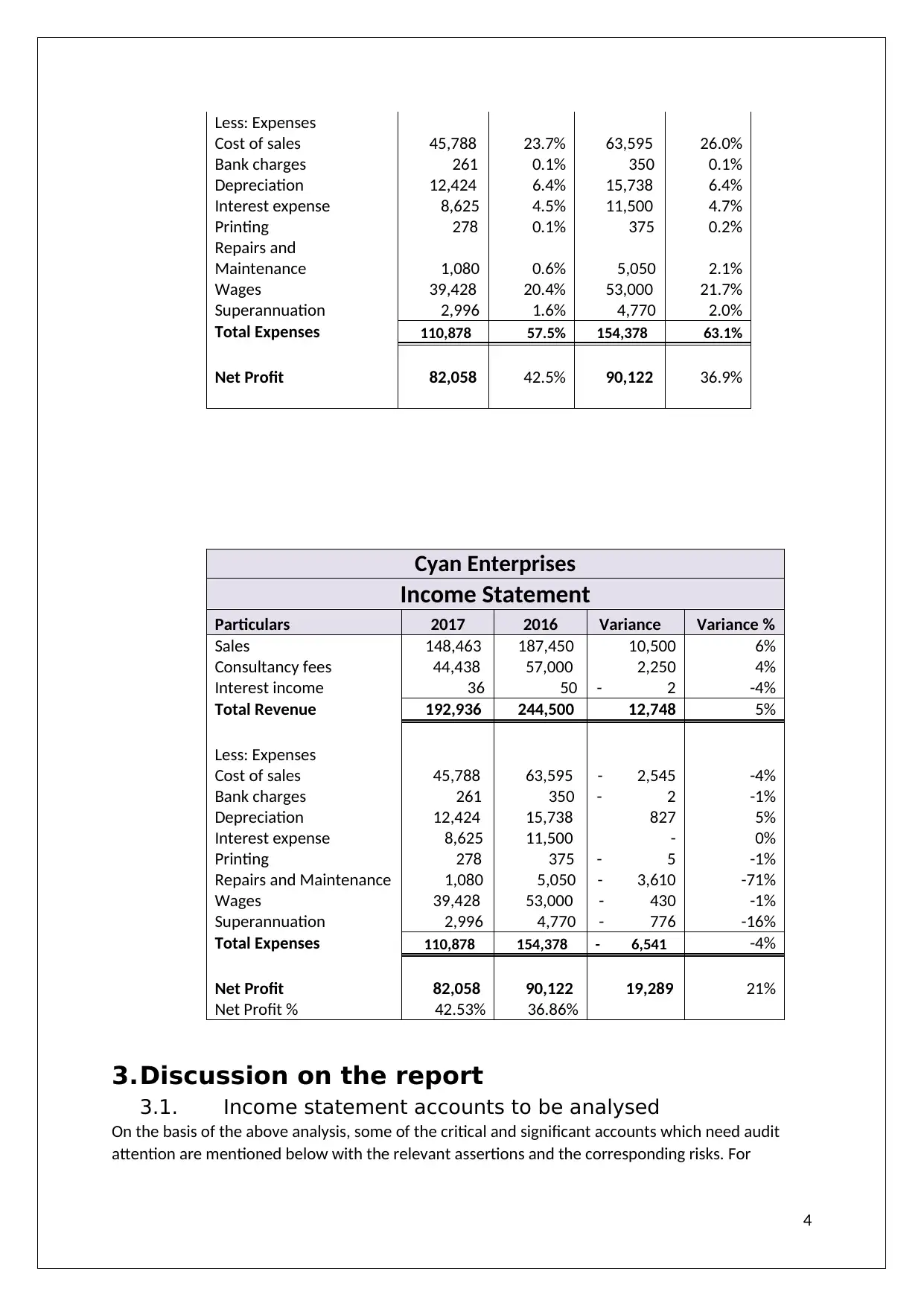
Less: Expenses
Cost of sales 45,788 23.7% 63,595 26.0%
Bank charges 261 0.1% 350 0.1%
Depreciation 12,424 6.4% 15,738 6.4%
Interest expense 8,625 4.5% 11,500 4.7%
Printing 278 0.1% 375 0.2%
Repairs and
Maintenance 1,080 0.6% 5,050 2.1%
Wages 39,428 20.4% 53,000 21.7%
Superannuation 2,996 1.6% 4,770 2.0%
Total Expenses 110,878 57.5% 154,378 63.1%
Net Profit 82,058 42.5% 90,122 36.9%
Cyan Enterprises
Income Statement
Particulars 2017 2016 Variance Variance %
Sales 148,463 187,450 10,500 6%
Consultancy fees 44,438 57,000 2,250 4%
Interest income 36 50 - 2 -4%
Total Revenue 192,936 244,500 12,748 5%
Less: Expenses
Cost of sales 45,788 63,595 - 2,545 -4%
Bank charges 261 350 - 2 -1%
Depreciation 12,424 15,738 827 5%
Interest expense 8,625 11,500 - 0%
Printing 278 375 - 5 -1%
Repairs and Maintenance 1,080 5,050 - 3,610 -71%
Wages 39,428 53,000 - 430 -1%
Superannuation 2,996 4,770 - 776 -16%
Total Expenses 110,878 154,378 - 6,541 -4%
Net Profit 82,058 90,122 19,289 21%
Net Profit % 42.53% 36.86%
3.Discussion on the report
3.1. Income statement accounts to be analysed
On the basis of the above analysis, some of the critical and significant accounts which need audit
attention are mentioned below with the relevant assertions and the corresponding risks. For
4
Cost of sales 45,788 23.7% 63,595 26.0%
Bank charges 261 0.1% 350 0.1%
Depreciation 12,424 6.4% 15,738 6.4%
Interest expense 8,625 4.5% 11,500 4.7%
Printing 278 0.1% 375 0.2%
Repairs and
Maintenance 1,080 0.6% 5,050 2.1%
Wages 39,428 20.4% 53,000 21.7%
Superannuation 2,996 1.6% 4,770 2.0%
Total Expenses 110,878 57.5% 154,378 63.1%
Net Profit 82,058 42.5% 90,122 36.9%
Cyan Enterprises
Income Statement
Particulars 2017 2016 Variance Variance %
Sales 148,463 187,450 10,500 6%
Consultancy fees 44,438 57,000 2,250 4%
Interest income 36 50 - 2 -4%
Total Revenue 192,936 244,500 12,748 5%
Less: Expenses
Cost of sales 45,788 63,595 - 2,545 -4%
Bank charges 261 350 - 2 -1%
Depreciation 12,424 15,738 827 5%
Interest expense 8,625 11,500 - 0%
Printing 278 375 - 5 -1%
Repairs and Maintenance 1,080 5,050 - 3,610 -71%
Wages 39,428 53,000 - 430 -1%
Superannuation 2,996 4,770 - 776 -16%
Total Expenses 110,878 154,378 - 6,541 -4%
Net Profit 82,058 90,122 19,289 21%
Net Profit % 42.53% 36.86%
3.Discussion on the report
3.1. Income statement accounts to be analysed
On the basis of the above analysis, some of the critical and significant accounts which need audit
attention are mentioned below with the relevant assertions and the corresponding risks. For
4
Paraphrase This Document
Need a fresh take? Get an instant paraphrase of this document with our AI Paraphraser
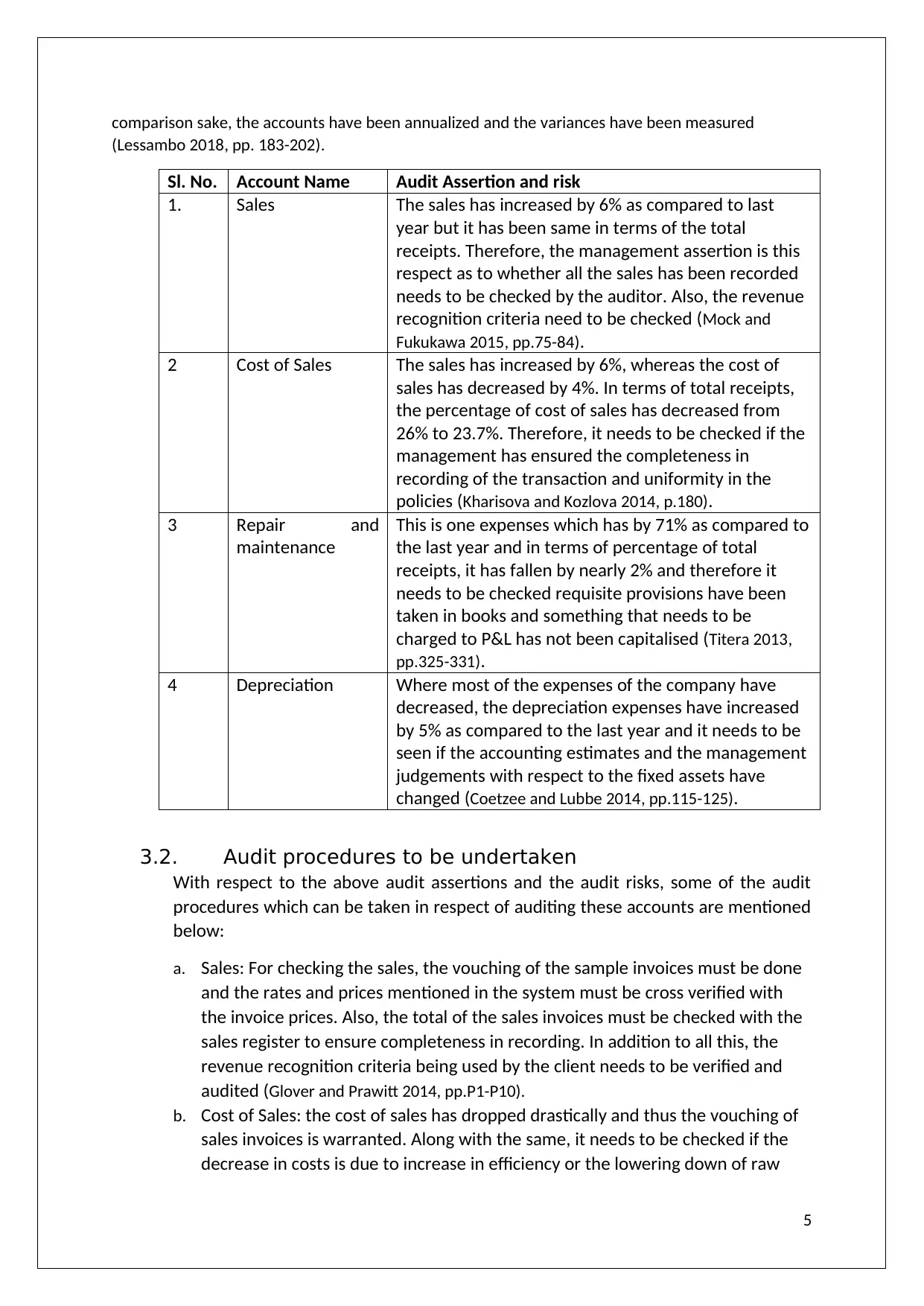
comparison sake, the accounts have been annualized and the variances have been measured
(Lessambo 2018, pp. 183-202).
Sl. No. Account Name Audit Assertion and risk
1. Sales The sales has increased by 6% as compared to last
year but it has been same in terms of the total
receipts. Therefore, the management assertion is this
respect as to whether all the sales has been recorded
needs to be checked by the auditor. Also, the revenue
recognition criteria need to be checked (Mock and
Fukukawa 2015, pp.75-84).
2 Cost of Sales The sales has increased by 6%, whereas the cost of
sales has decreased by 4%. In terms of total receipts,
the percentage of cost of sales has decreased from
26% to 23.7%. Therefore, it needs to be checked if the
management has ensured the completeness in
recording of the transaction and uniformity in the
policies (Kharisova and Kozlova 2014, p.180).
3 Repair and
maintenance
This is one expenses which has by 71% as compared to
the last year and in terms of percentage of total
receipts, it has fallen by nearly 2% and therefore it
needs to be checked requisite provisions have been
taken in books and something that needs to be
charged to P&L has not been capitalised (Titera 2013,
pp.325-331).
4 Depreciation Where most of the expenses of the company have
decreased, the depreciation expenses have increased
by 5% as compared to the last year and it needs to be
seen if the accounting estimates and the management
judgements with respect to the fixed assets have
changed (Coetzee and Lubbe 2014, pp.115-125).
3.2. Audit procedures to be undertaken
With respect to the above audit assertions and the audit risks, some of the audit
procedures which can be taken in respect of auditing these accounts are mentioned
below:
a. Sales: For checking the sales, the vouching of the sample invoices must be done
and the rates and prices mentioned in the system must be cross verified with
the invoice prices. Also, the total of the sales invoices must be checked with the
sales register to ensure completeness in recording. In addition to all this, the
revenue recognition criteria being used by the client needs to be verified and
audited (Glover and Prawitt 2014, pp.P1-P10).
b. Cost of Sales: the cost of sales has dropped drastically and thus the vouching of
sales invoices is warranted. Along with the same, it needs to be checked if the
decrease in costs is due to increase in efficiency or the lowering down of raw
5
(Lessambo 2018, pp. 183-202).
Sl. No. Account Name Audit Assertion and risk
1. Sales The sales has increased by 6% as compared to last
year but it has been same in terms of the total
receipts. Therefore, the management assertion is this
respect as to whether all the sales has been recorded
needs to be checked by the auditor. Also, the revenue
recognition criteria need to be checked (Mock and
Fukukawa 2015, pp.75-84).
2 Cost of Sales The sales has increased by 6%, whereas the cost of
sales has decreased by 4%. In terms of total receipts,
the percentage of cost of sales has decreased from
26% to 23.7%. Therefore, it needs to be checked if the
management has ensured the completeness in
recording of the transaction and uniformity in the
policies (Kharisova and Kozlova 2014, p.180).
3 Repair and
maintenance
This is one expenses which has by 71% as compared to
the last year and in terms of percentage of total
receipts, it has fallen by nearly 2% and therefore it
needs to be checked requisite provisions have been
taken in books and something that needs to be
charged to P&L has not been capitalised (Titera 2013,
pp.325-331).
4 Depreciation Where most of the expenses of the company have
decreased, the depreciation expenses have increased
by 5% as compared to the last year and it needs to be
seen if the accounting estimates and the management
judgements with respect to the fixed assets have
changed (Coetzee and Lubbe 2014, pp.115-125).
3.2. Audit procedures to be undertaken
With respect to the above audit assertions and the audit risks, some of the audit
procedures which can be taken in respect of auditing these accounts are mentioned
below:
a. Sales: For checking the sales, the vouching of the sample invoices must be done
and the rates and prices mentioned in the system must be cross verified with
the invoice prices. Also, the total of the sales invoices must be checked with the
sales register to ensure completeness in recording. In addition to all this, the
revenue recognition criteria being used by the client needs to be verified and
audited (Glover and Prawitt 2014, pp.P1-P10).
b. Cost of Sales: the cost of sales has dropped drastically and thus the vouching of
sales invoices is warranted. Along with the same, it needs to be checked if the
decrease in costs is due to increase in efficiency or the lowering down of raw
5
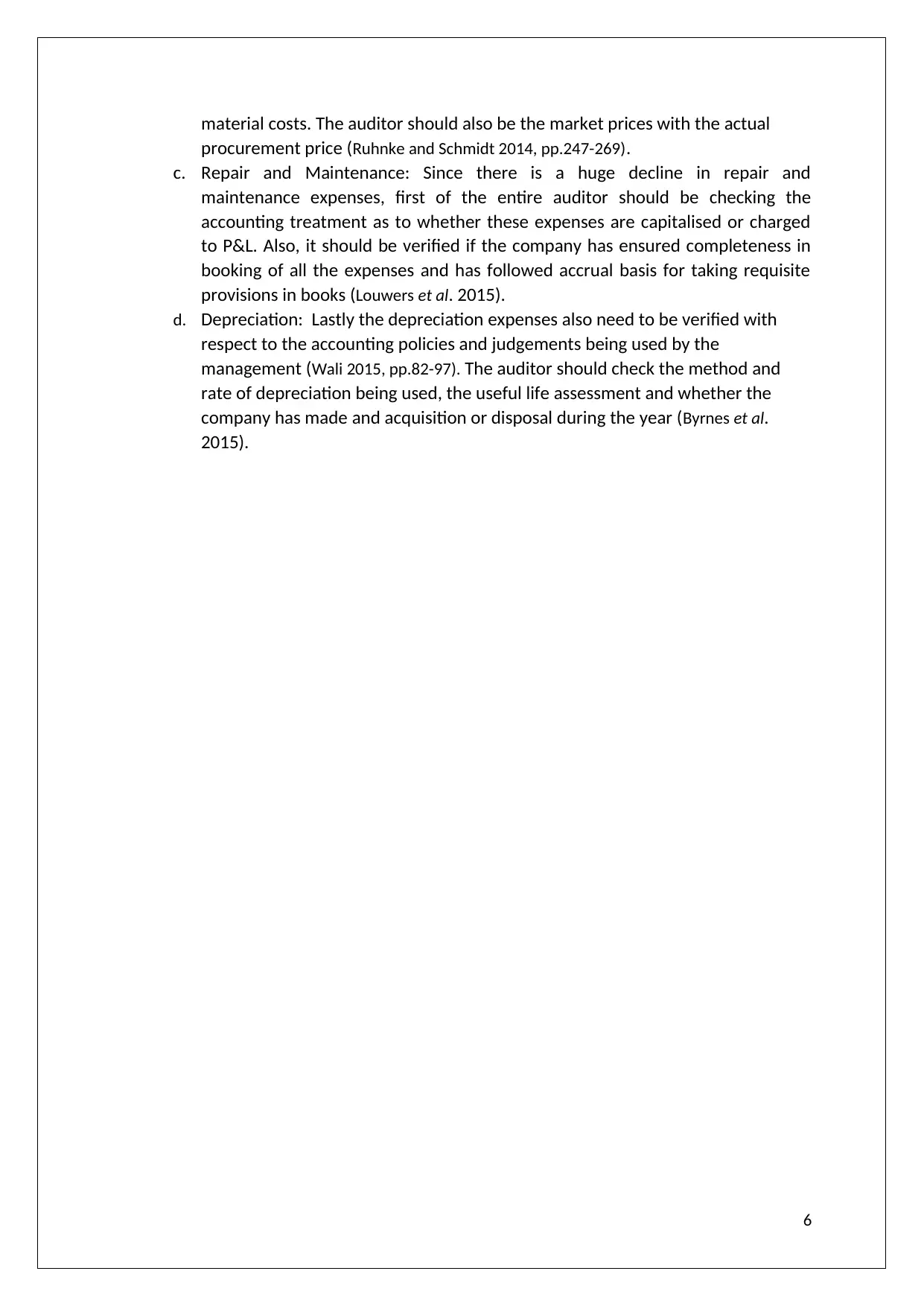
material costs. The auditor should also be the market prices with the actual
procurement price (Ruhnke and Schmidt 2014, pp.247-269).
c. Repair and Maintenance: Since there is a huge decline in repair and
maintenance expenses, first of the entire auditor should be checking the
accounting treatment as to whether these expenses are capitalised or charged
to P&L. Also, it should be verified if the company has ensured completeness in
booking of all the expenses and has followed accrual basis for taking requisite
provisions in books (Louwers et al. 2015).
d. Depreciation: Lastly the depreciation expenses also need to be verified with
respect to the accounting policies and judgements being used by the
management (Wali 2015, pp.82-97). The auditor should check the method and
rate of depreciation being used, the useful life assessment and whether the
company has made and acquisition or disposal during the year (Byrnes et al.
2015).
6
procurement price (Ruhnke and Schmidt 2014, pp.247-269).
c. Repair and Maintenance: Since there is a huge decline in repair and
maintenance expenses, first of the entire auditor should be checking the
accounting treatment as to whether these expenses are capitalised or charged
to P&L. Also, it should be verified if the company has ensured completeness in
booking of all the expenses and has followed accrual basis for taking requisite
provisions in books (Louwers et al. 2015).
d. Depreciation: Lastly the depreciation expenses also need to be verified with
respect to the accounting policies and judgements being used by the
management (Wali 2015, pp.82-97). The auditor should check the method and
rate of depreciation being used, the useful life assessment and whether the
company has made and acquisition or disposal during the year (Byrnes et al.
2015).
6
⊘ This is a preview!⊘
Do you want full access?
Subscribe today to unlock all pages.

Trusted by 1+ million students worldwide
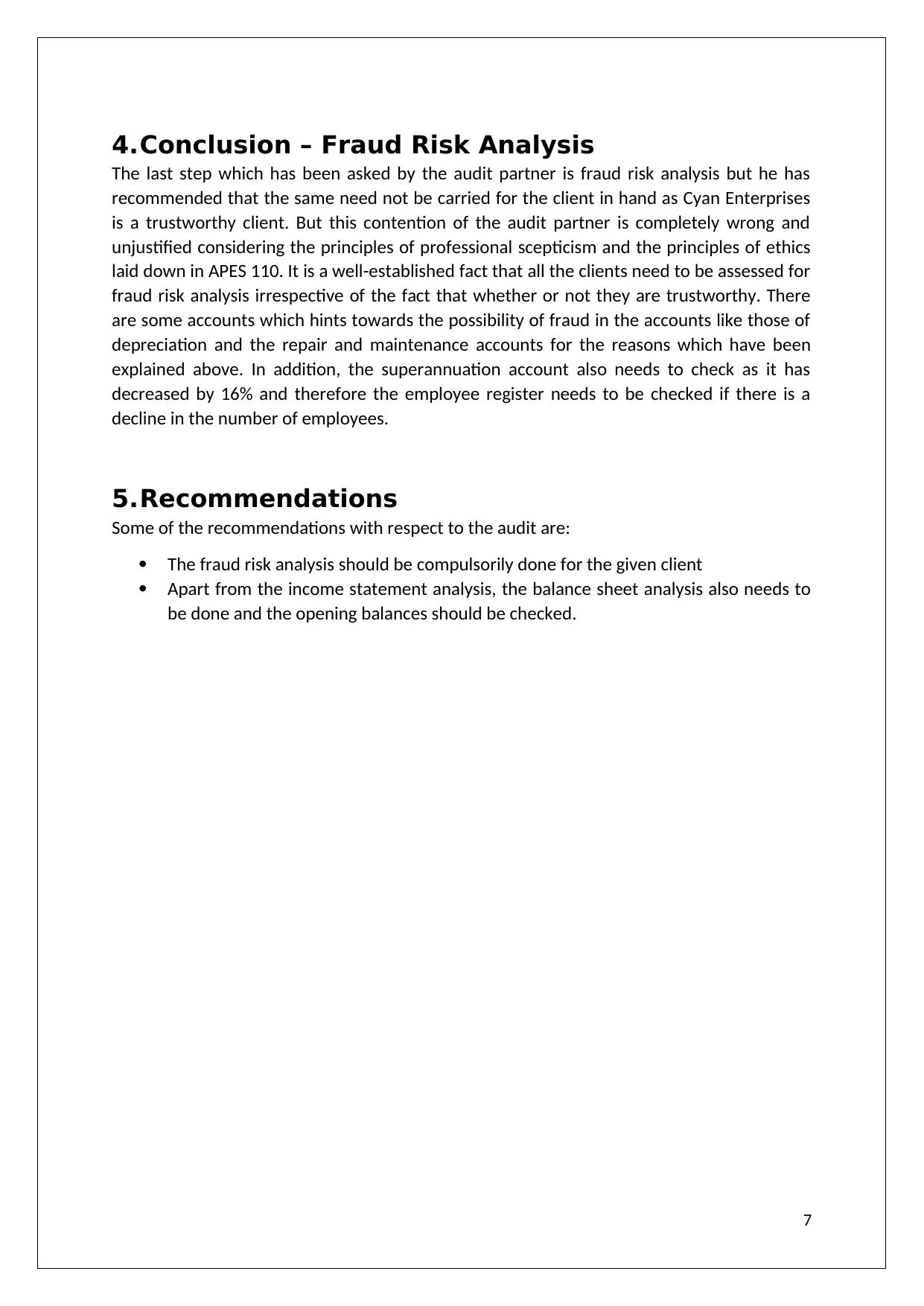
4.Conclusion – Fraud Risk Analysis
The last step which has been asked by the audit partner is fraud risk analysis but he has
recommended that the same need not be carried for the client in hand as Cyan Enterprises
is a trustworthy client. But this contention of the audit partner is completely wrong and
unjustified considering the principles of professional scepticism and the principles of ethics
laid down in APES 110. It is a well-established fact that all the clients need to be assessed for
fraud risk analysis irrespective of the fact that whether or not they are trustworthy. There
are some accounts which hints towards the possibility of fraud in the accounts like those of
depreciation and the repair and maintenance accounts for the reasons which have been
explained above. In addition, the superannuation account also needs to check as it has
decreased by 16% and therefore the employee register needs to be checked if there is a
decline in the number of employees.
5.Recommendations
Some of the recommendations with respect to the audit are:
The fraud risk analysis should be compulsorily done for the given client
Apart from the income statement analysis, the balance sheet analysis also needs to
be done and the opening balances should be checked.
7
The last step which has been asked by the audit partner is fraud risk analysis but he has
recommended that the same need not be carried for the client in hand as Cyan Enterprises
is a trustworthy client. But this contention of the audit partner is completely wrong and
unjustified considering the principles of professional scepticism and the principles of ethics
laid down in APES 110. It is a well-established fact that all the clients need to be assessed for
fraud risk analysis irrespective of the fact that whether or not they are trustworthy. There
are some accounts which hints towards the possibility of fraud in the accounts like those of
depreciation and the repair and maintenance accounts for the reasons which have been
explained above. In addition, the superannuation account also needs to check as it has
decreased by 16% and therefore the employee register needs to be checked if there is a
decline in the number of employees.
5.Recommendations
Some of the recommendations with respect to the audit are:
The fraud risk analysis should be compulsorily done for the given client
Apart from the income statement analysis, the balance sheet analysis also needs to
be done and the opening balances should be checked.
7
Paraphrase This Document
Need a fresh take? Get an instant paraphrase of this document with our AI Paraphraser
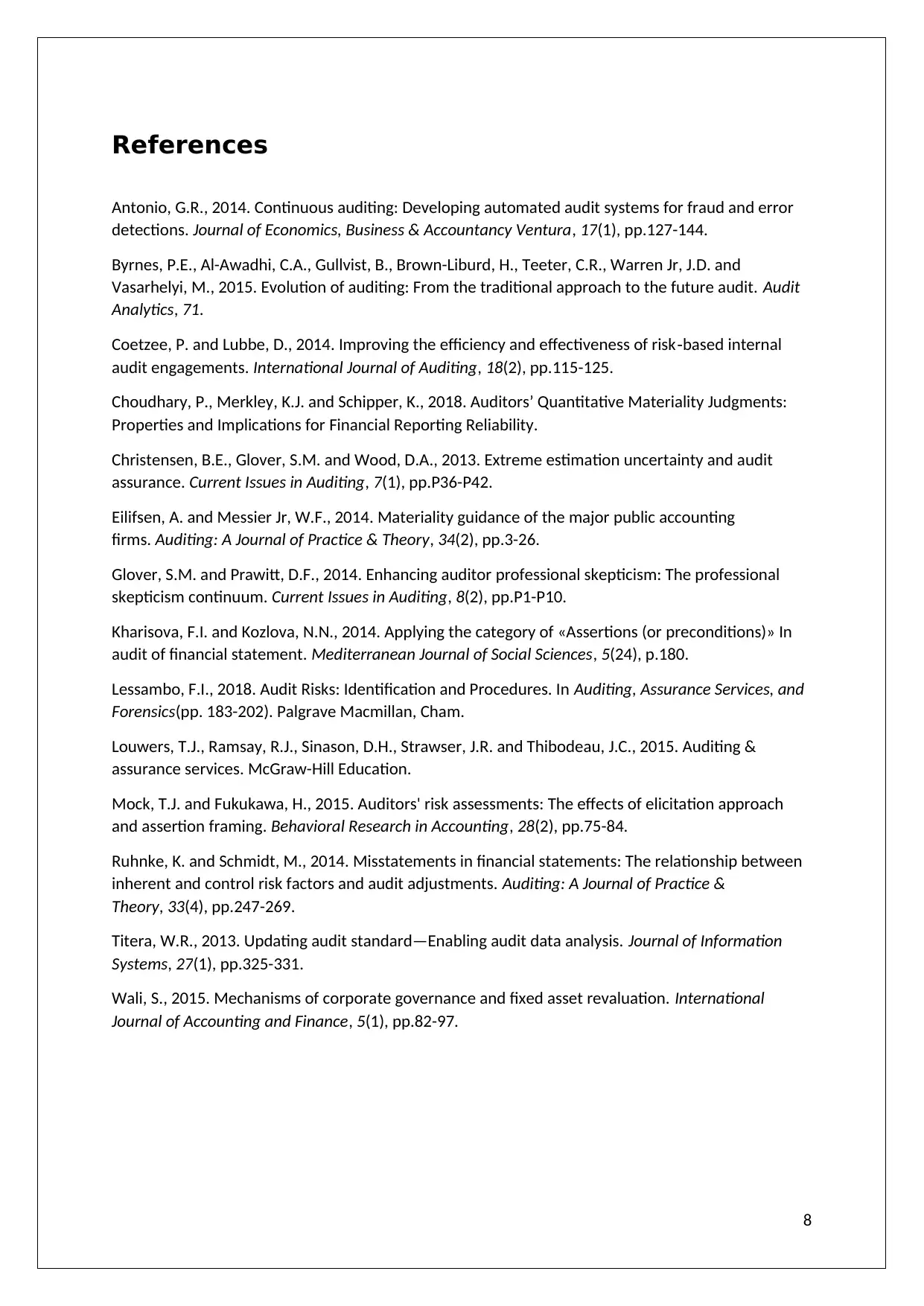
References
Antonio, G.R., 2014. Continuous auditing: Developing automated audit systems for fraud and error
detections. Journal of Economics, Business & Accountancy Ventura, 17(1), pp.127-144.
Byrnes, P.E., Al-Awadhi, C.A., Gullvist, B., Brown-Liburd, H., Teeter, C.R., Warren Jr, J.D. and
Vasarhelyi, M., 2015. Evolution of auditing: From the traditional approach to the future audit. Audit
Analytics, 71.
Coetzee, P. and Lubbe, D., 2014. Improving the efficiency and effectiveness of risk‐based internal
audit engagements. International Journal of Auditing, 18(2), pp.115-125.
Choudhary, P., Merkley, K.J. and Schipper, K., 2018. Auditors’ Quantitative Materiality Judgments:
Properties and Implications for Financial Reporting Reliability.
Christensen, B.E., Glover, S.M. and Wood, D.A., 2013. Extreme estimation uncertainty and audit
assurance. Current Issues in Auditing, 7(1), pp.P36-P42.
Eilifsen, A. and Messier Jr, W.F., 2014. Materiality guidance of the major public accounting
firms. Auditing: A Journal of Practice & Theory, 34(2), pp.3-26.
Glover, S.M. and Prawitt, D.F., 2014. Enhancing auditor professional skepticism: The professional
skepticism continuum. Current Issues in Auditing, 8(2), pp.P1-P10.
Kharisova, F.I. and Kozlova, N.N., 2014. Applying the category of «Assertions (or preconditions)» In
audit of financial statement. Mediterranean Journal of Social Sciences, 5(24), p.180.
Lessambo, F.I., 2018. Audit Risks: Identification and Procedures. In Auditing, Assurance Services, and
Forensics(pp. 183-202). Palgrave Macmillan, Cham.
Louwers, T.J., Ramsay, R.J., Sinason, D.H., Strawser, J.R. and Thibodeau, J.C., 2015. Auditing &
assurance services. McGraw-Hill Education.
Mock, T.J. and Fukukawa, H., 2015. Auditors' risk assessments: The effects of elicitation approach
and assertion framing. Behavioral Research in Accounting, 28(2), pp.75-84.
Ruhnke, K. and Schmidt, M., 2014. Misstatements in financial statements: The relationship between
inherent and control risk factors and audit adjustments. Auditing: A Journal of Practice &
Theory, 33(4), pp.247-269.
Titera, W.R., 2013. Updating audit standard—Enabling audit data analysis. Journal of Information
Systems, 27(1), pp.325-331.
Wali, S., 2015. Mechanisms of corporate governance and fixed asset revaluation. International
Journal of Accounting and Finance, 5(1), pp.82-97.
8
Antonio, G.R., 2014. Continuous auditing: Developing automated audit systems for fraud and error
detections. Journal of Economics, Business & Accountancy Ventura, 17(1), pp.127-144.
Byrnes, P.E., Al-Awadhi, C.A., Gullvist, B., Brown-Liburd, H., Teeter, C.R., Warren Jr, J.D. and
Vasarhelyi, M., 2015. Evolution of auditing: From the traditional approach to the future audit. Audit
Analytics, 71.
Coetzee, P. and Lubbe, D., 2014. Improving the efficiency and effectiveness of risk‐based internal
audit engagements. International Journal of Auditing, 18(2), pp.115-125.
Choudhary, P., Merkley, K.J. and Schipper, K., 2018. Auditors’ Quantitative Materiality Judgments:
Properties and Implications for Financial Reporting Reliability.
Christensen, B.E., Glover, S.M. and Wood, D.A., 2013. Extreme estimation uncertainty and audit
assurance. Current Issues in Auditing, 7(1), pp.P36-P42.
Eilifsen, A. and Messier Jr, W.F., 2014. Materiality guidance of the major public accounting
firms. Auditing: A Journal of Practice & Theory, 34(2), pp.3-26.
Glover, S.M. and Prawitt, D.F., 2014. Enhancing auditor professional skepticism: The professional
skepticism continuum. Current Issues in Auditing, 8(2), pp.P1-P10.
Kharisova, F.I. and Kozlova, N.N., 2014. Applying the category of «Assertions (or preconditions)» In
audit of financial statement. Mediterranean Journal of Social Sciences, 5(24), p.180.
Lessambo, F.I., 2018. Audit Risks: Identification and Procedures. In Auditing, Assurance Services, and
Forensics(pp. 183-202). Palgrave Macmillan, Cham.
Louwers, T.J., Ramsay, R.J., Sinason, D.H., Strawser, J.R. and Thibodeau, J.C., 2015. Auditing &
assurance services. McGraw-Hill Education.
Mock, T.J. and Fukukawa, H., 2015. Auditors' risk assessments: The effects of elicitation approach
and assertion framing. Behavioral Research in Accounting, 28(2), pp.75-84.
Ruhnke, K. and Schmidt, M., 2014. Misstatements in financial statements: The relationship between
inherent and control risk factors and audit adjustments. Auditing: A Journal of Practice &
Theory, 33(4), pp.247-269.
Titera, W.R., 2013. Updating audit standard—Enabling audit data analysis. Journal of Information
Systems, 27(1), pp.325-331.
Wali, S., 2015. Mechanisms of corporate governance and fixed asset revaluation. International
Journal of Accounting and Finance, 5(1), pp.82-97.
8
1 out of 11
Related Documents
Your All-in-One AI-Powered Toolkit for Academic Success.
+13062052269
info@desklib.com
Available 24*7 on WhatsApp / Email
![[object Object]](/_next/static/media/star-bottom.7253800d.svg)
Unlock your academic potential
Copyright © 2020–2025 A2Z Services. All Rights Reserved. Developed and managed by ZUCOL.





